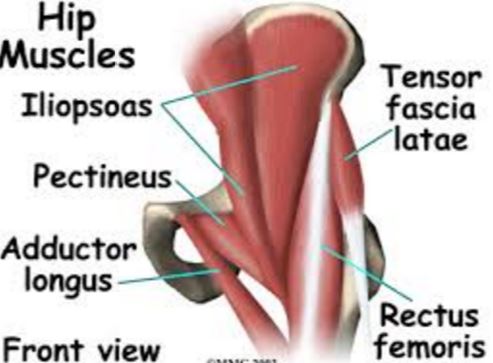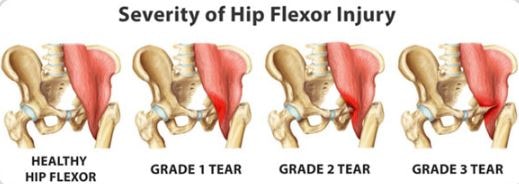Hip Flexor Pain
What is Hip Flexor Pain?
Hip flexor pain is commonly felt by older adults and athletes who are engage in sports that involves running and kicking. The discomfort that can be felt ranges from manageable to debilitating pain [1, 2].
Hip Flexor Muscles
The hip flexor muscle is the group of muscle that is responsible for flexion in the hip area. There are four muscles in this area but the most important are the iliacus and the psoas major. The iliacus originates from the iliac crest while the psoas muscle comes from the disc of T12 and all the vertebrae in the lumbar section of the spine. Together, these muscles are known as the iliopsoas muscle. Figure 1 shows the location of the hip flexor muscle group [3, 4, 5].
 |||
||| 
Figure 1- The Hip Flexor Muscles
The main function of the hip flexor muscles is to enable full range of motion of the hip joints. These muscles assist in drawing the knee to the chest and side to side movement of the legs. This muscle group connects the torso to the legs and make them move in coordination to each other [6].
Causes
There are several reasons causes of the pain in the hip flexor area.
Hip flexor strain
Straining of the hip flexor muscles occur when they are stretched beyond their limits. Although it can occur with the performance of everyday tasks, most of hip flexor strain injuries are obtained in sports that involve kicking and running such as football and soccer. These activities may tear the hip flexor muscles and cause the pain. The damage ranges from minor tear of the muscles to complete rupture of muscle fibers [2].

Hip arthritis
This is a degenerative condition where the surfaces of the bone and cartilages of the hip wear down. Arthritis affect the smooth movement of the hip joint. This may happen after an injurious incident or due to repetitive overwhelming force to the hip after a certain period of time. As the condition progresses, there will be severe pain that will be felt in front of the hip and may extend to the buttock region [7].
Hip tendonitis
Overuse of the hip flexor muscles may lead to inflammation of the tendon or tendonitis. This injury is also obtained either from an acute injury or muscle overuse. Individuals who engage in running, cycling, soccer, hockey and football are at risk for this injury [8].
Hip Flexor Pain Symptoms
Aside from the pain, these are the other symptoms that may be felt by the individual [2, 8].
- Swelling and tenderness
- Pain intensified with continuous use of the muscle.
- Decreased range of motion
- Weakness of the muscles
Diagnosis
Health history and physical examination
Medical history is essential in identifying the cause of the hip flexor pain. The incident that must have caused the pain must be described as detailed as possible. Characteristics of the pain such as intensity, location and relief shall be discussed. Any previous occurrence of the same problem shall be noted as well [7, 8].
The physical examination will include inspection and palpation of the frontal hip area. The knee and the lumbosacral area will be included in the examination to verify if the hip pain is a referred pain. Strength testing and range of motion exercises will be perform to identify any deficit in the hip’s ROM [7, 8].
Imaging test
Imaging tests such as X-ray, Computerized Tomography (CT) scan and a Magnetic Resonance Imaging (MRI) may be requested by a physician to assist in identifying the cause of the pain. It will be able to show the condition of the tissues of the hip flexor muscle [7, 8].
Treatment
The goal of the treatment for hip pain is to relieve the symptoms and restore the muscle strength and range of motion. As soon as the pain is felt, stop doing the activity that caused it. Take a break and protect the hip area.
Apply ice or cold pack regularly to help reduce the pain and the swelling. It is advisable to put ice over the area for 10-20 minutes for more than 3 times a day. The hips must be elevated to prevent further swelling in the area. Nonsteroidal anti-inflammatory Naproxen and Ibuprofen are the usual pain medications that are prescribed by the physician [2, 7, 8].
Physical Therapy
This aspect of the treatment process is essential to minimize the pain and prevent the condition from progressing. Lengthening the muscle-tendon unit of the injured muscle and increasing its flexibility are the important aspects of the therapy.
This goal is achieved with active stretching of the injured hip muscle with the help of the physical therapist. Patients should be advised to wait until the muscle’s pre-injury flexibility and strength have returned before engaging in any sports activity [2, 7, 8].
References
- Brown, J. (2009, June 29). Everything You Need to Know About Hip Injuries. Retrieved from Exos Knowledge: http://www.coreperformance.com/knowledge/injury-pain/hip-injuries.html
- Ortho Info. (2014, December). Hip Strains. Retrieved from Ortho Info: http://orthoinfo.aaos.org/topic.cfm?topic=A00361
- Healthline Medical Team. (2015, March 11). Iliacus. Retrieved from Healthline: http://www.healthline.com/human-body-maps/iliacus-muscle
- Acland’s Video Atlas of Human Anatomy. (2015). Hip Flexor Muscles. Retrieved from Acland’s Video Atlas of Human Anatomy: http://aclandanatomy.com/multimediaplayer.aspx?multimediaid=10528145
- American Academy of Manual Medicine. (2007). Iliopsoas Muscle Group: Psoas Minor, Psoas Major, and Iliacus. Retrieved from American Academy of Manual Medicine: http://www.webmanmed.com/disorders/disorders_files/musclgd/lowback/14850061.html
- Fitday. (2015). Why Your Hip Flexor Health is Vital. Retrieved from Fitday: http://www.fitday.com/fitness-articles/fitness/exercises/why-your-hip-flexor-health-is-vital.html
- McGorry, A. (2015). Hip Tendonitis. Retrieved from WebMD: http://www.webmd.com/fitness-exercise/hip-tendonitis?page=2
- Rosenberg, J. (2015, October 8). Hip Tendonitis and Bursitis Treatment & Management. Retrieved from Medscape: http://emedicine.medscape.com/article/87169-treatment
